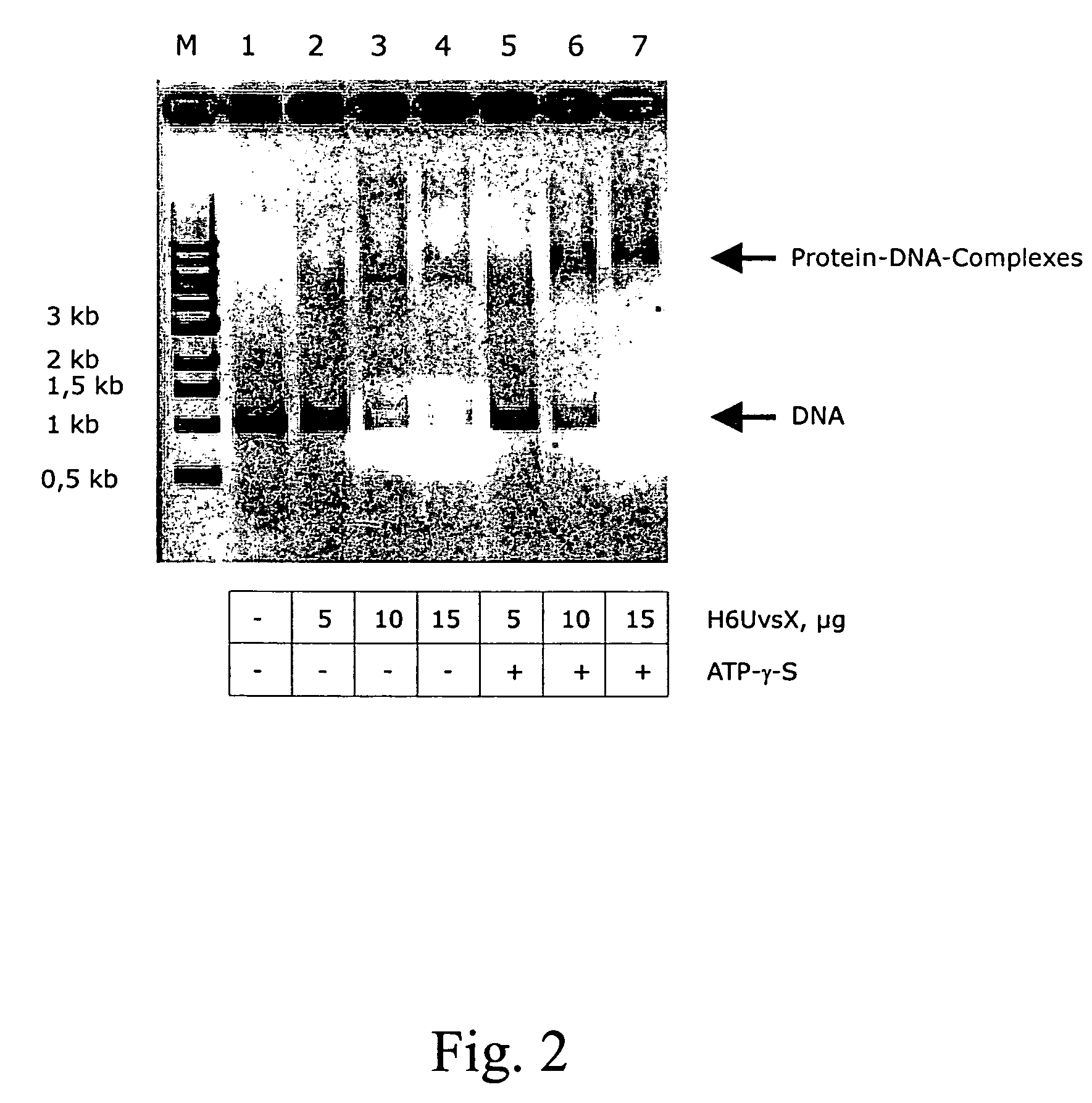Modular transfection systems
a module-based, nucleic acid technology, applied in the direction of peptides, polypeptides with his-tags, enzymology, etc., can solve the problems of inability to penetrate the external cell membrane or the membrane of internal compartments, lack of controllability of one or several transfection steps, and large size of globular nucleic acid complexes, etc., to achieve high loading, increase the stability of hydrolysis, and low diameter
- Summary
- Abstract
- Description
- Claims
- Application Information
AI Technical Summary
Benefits of technology
Problems solved by technology
Method used
Image
Examples
example 1
Generation of Recombinant UvsX as NPF Forming Proteins
[0121]The proteins UvsXH6, UvsXH6-2, H6UvsX und H6UvsX-2 were used as NPF forming proteins (see FIG. 1).
Structure of the Proteins:
UvsXH6 (400 amino acids):
[0122]Amino acids 1-391: UvsX from the phage T4 (NCBI protein accession no: AAD42669, amino acids 1-391), amino acids 392-394: linker consisting of the amino acids G392GS394, amino acid 395-400: H395HHHHH400 for purification by nickel chelate affinity chromatography, amino acid exchange: L43→P.
UvsXH6-2 (403 amino acids):
[0123]Amino acids 1-391: UvsX from the phage T4 (NCBI protein accession no: AAD42669, amino acids 1-391), amino acids 392-394: linker consisting of the S392YG394, amino acids 395-400: H395HHHHH400, amino acids 401-403: C-terminus consisting of the amino acids M401YS403.
H6UvsX (404 amino acids):
[0124]Amino acids 1-4: N-terminus consisting of the amino acids M1SYS4, amino acids 5-10: H5HHHHH10, amino acids 11-13: linker consisting of the amino acids S11YG13, amino...
example 2
Generation of a Transfecting Agent, Based on UvsX as NPF Forming Protein With a Nuclear Localization Signal as a Functional Component.
[0136]As in example 1, plasmids were generated which permit the expression of the fusion proteins UvsXH6N2, UvsXH6N2-2, N2H6UvsX and N2H6UvsX-2, which are based on the proteins described in example 1, and in addition contain a nuclear localization signal (see FIG. 1).
Structure of the Proteins:
UvsXH6N2 (426 amino acids):
[0137]Amino acids 1-391: UvsX from the phage T4 (NCBI protein accession no.: AAD42669, amino acids 1-391), amino acids 392-394: linker consisting of the amino acids G392G S394, amino acids 395-400: H395HHHHH400, amino acids 401-403: linker consisting of the amino acids G401GS403, amino acids 404-417: nuclear localization signal nls-2 (amino acids 2-15, SEQ ID NO: 9 from WO 00 / 40742), amino acids 418-421: C-terminus of UvsX from the phage T4 (NCBI protein accession no: AAD42669, amino acids 388-391), amino acids 422-426: C-terminus consi...
example 3
Generation of a Transfection Agent With a Mixture of Modified and Unmodified NPF-Forming Protein
Description of the Experiment:
[0145]Various ratios of H6UvsX and UvsxH6N2 were incubated with a 1 kb DNA fragment. The two proteins retarded the DNA in different degrees, due to their different molecular weight (see column 2 and 3 of FIG. 4). If the proteins are mixed before addition of DNA, intermediate complexes are formed based on the ratio of H6UvsX to UvsXH6N2, which yield a sharp band and therefore have an equal mean molecular weight. This shows that the DNA is statistically equally occupied by both proteins.
PUM
| Property | Measurement | Unit |
|---|---|---|
| diameter | aaaaa | aaaaa |
| diameters | aaaaa | aaaaa |
| diameter | aaaaa | aaaaa |
Abstract
Description
Claims
Application Information
 Login to View More
Login to View More - R&D
- Intellectual Property
- Life Sciences
- Materials
- Tech Scout
- Unparalleled Data Quality
- Higher Quality Content
- 60% Fewer Hallucinations
Browse by: Latest US Patents, China's latest patents, Technical Efficacy Thesaurus, Application Domain, Technology Topic, Popular Technical Reports.
© 2025 PatSnap. All rights reserved.Legal|Privacy policy|Modern Slavery Act Transparency Statement|Sitemap|About US| Contact US: help@patsnap.com



